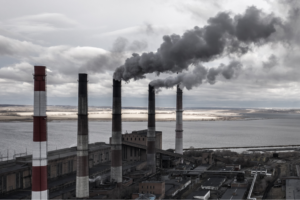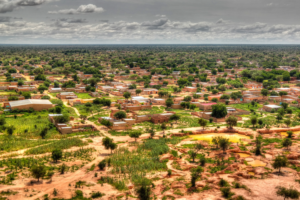Climate crisis: Governments failing on mitigation and adaptation
Written by Olivia Nater | Published: November 3, 2023
World leaders are failing abysmally on climate change mitigation, with global emissions continuing to increase, when what is needed to prevent catastrophic warming is a drastic reduction. Two new studies estimate that at current carbon emission rates, we will breach the critical 1.5°C threshold before 2030. In addition, a UN report reveals that climate adaptation funding for the most vulnerable countries has decreased, while these places face increasingly devastating impacts.
Still breaking the wrong records
In 2015 in Paris, governments pledged to limit warming relative to pre-industrial times to “well below” 2°C, and “preferably” to 1.5°C. The research shows that exceeding 1.5°C significantly increases the risk of triggering dangerous tipping points, leading to catastrophic events such as rapid sea level rise, escalating droughts and floods, the extinction of coral reefs, and massive greenhouse gas release from thawing permafrost.
Considering the huge existential risk climate change presents, it is astounding that seven years on from the Paris Agreement entering into force on November 4, 2016, we are still moving in the wrong direction, with atmospheric carbon dioxide (CO2) reaching a new record high ever year.
The average temperature on Earth is already at least 1.1°C higher than during the pre-industrial era, with the summer months bringing new heat records every year, including temporary breaches of the 1.5°C target.
On track to pass 1.5°C this decade
 A study published on Monday in Nature Climate Change uses sophisticated models to provide a new estimate of our remaining carbon budget, the amount of carbon that humanity can emit without exceeding the 1.5°C threshold. It found that for a 50 percent chance of keeping warming to 1.5°C, the budget was around 250 GtCO2 as of January 2023. This means that if greenhouse gases continue to be emitted at the current rate, the budget will be spent by early 2029. This estimate is three years earlier than a previous one calculated by the Intergovernmental Panel on Climate Change (IPCC) in 2021.
A study published on Monday in Nature Climate Change uses sophisticated models to provide a new estimate of our remaining carbon budget, the amount of carbon that humanity can emit without exceeding the 1.5°C threshold. It found that for a 50 percent chance of keeping warming to 1.5°C, the budget was around 250 GtCO2 as of January 2023. This means that if greenhouse gases continue to be emitted at the current rate, the budget will be spent by early 2029. This estimate is three years earlier than a previous one calculated by the Intergovernmental Panel on Climate Change (IPCC) in 2021.
An additional, independent study, published on Thursday in Oxford Open Climate Change, corroborates these findings, stating that we will likely surpass 1.5°C in the 2020s, and 2°C before 2050. The lead author, James Hansen, is a former NASA scientist who played a key role in alerting the U.S. to climate change impacts in a 1988 congressional testimony. According to his new paper, the average rate of global warming was around 0.18°C per decade between 1970 and 2010. Due to a reduction in aerosols around 2010, the authors estimate an increase in warming to at least 0.27°C per decade post-2010. Aerosols are pollution particles suspended in the atmosphere, some of which reflect sunlight back into space. Ironically, while they are essential, efforts to reduce air pollution and fossil fuel combustion have the unintended consequence of allowing more of the sun’s rays to reach the planet’s surface, which could lead to more warming. Some climate scientists have expressed disagreement with these findings, however, saying there is no compelling evidence that global warming is accelerating and that the study exaggerates the role of aerosols. Nevertheless, the scientific consensus is that the 1.5°C target is rapidly moving out of reach.
Vulnerable communities increasingly left behind
A new report by the United Nations Environment Programme (UNEP), also published on Thursday, warns that “Current climate action is woefully inadequate to meet the temperature and adaptation goals of the Paris Agreement.”
The report showcases the injustice of the climate crisis, with the wealthiest nations that have precipitated the crisis failing to protect the developing countries that are now experiencing the worst impacts. According to the report, the total amount of international aid for climate change adaptation was $21 billion in 2021, a 15 percent decline relative to the year before. The report estimates that developing nations will need between $215 billion and $387 billion annually this decade to protect themselves against climate change impacts, including extreme weather events, water shortage and crop failures. This means that the current annual adaptation funding gap between what is needed and what has been pledged is now an enormous $194 to $366 billion.
The next UN climate summit, COP28, will take place in Dubai at the end of this month, where financial support for lower income countries will be a top agenda item. It is unlikely delegates from wealthy countries will pledge the required amount, however — at COP26 in Glasgow two years ago, countries agreed to increase their climate adaptation funding to at least $40 billion by 2025. Not only is this just a small share of what is needed — governments of high income countries also have a terrible track record of delivering on their promised financial support.
The UNEP report states that the 55 most climate-vulnerable countries alone have already suffered climate change damages of more than $500 in the last two decades, and warns that “These costs will rise steeply in the coming decades, particularly in the absence of strong mitigation and adaptation.”
Failure is not an option
 While helping countries prepare for climate change seems expensive, the humanitarian and economic costs of not doing so are much higher, especially in light of the most climate-vulnerable countries experiencing the fastest population growth. A critical climate mitigation and adaptation measure that is still widely neglected in international meetings and discussions is empowering women and girls by removing all barriers to family planning and education. These actions help limit greenhouse gas emissions by slowing population growth, and improve resilience to climate shocks by enabling women to enter the workforce and have the number of children they want and can provide for. In addition, they increase health and prosperity and can boost economic development.
While helping countries prepare for climate change seems expensive, the humanitarian and economic costs of not doing so are much higher, especially in light of the most climate-vulnerable countries experiencing the fastest population growth. A critical climate mitigation and adaptation measure that is still widely neglected in international meetings and discussions is empowering women and girls by removing all barriers to family planning and education. These actions help limit greenhouse gas emissions by slowing population growth, and improve resilience to climate shocks by enabling women to enter the workforce and have the number of children they want and can provide for. In addition, they increase health and prosperity and can boost economic development.
Time for reigning in catastrophic climate change is rapidly running out — more than ever before, humanity must come together and invest in empowering solutions that improve and protect lives, and ensure a livable planet for future generations and other species.

